
October 13, 2017; WBUR-FM, “The Artery”
What is the duty of a nonprofit board that is managing an arts collection in a small Rust Belt city?
Currently, this drama is playing out in the city of Pittsfield, Massachusetts, where the Berkshire Museum’s board this summer authorized a $60 million “reinvention plan,” which board trustees intend to capitalize largely through the sale of 40 art works by master painters, the sale of which they anticipate generating “proceeds to be in the region of $50 million.”
Among the art earmarked for the auction block are works by such name artists as Norman Rockwell, Alexander Calder, Albert Bierstadt, and George Henry Durrie. Many in the art world are aghast, and two leading museum associations, the Association of Art Museum Directors and the American Alliance of Museums, have issued a joint letter opposing the sale.
The plan, argue Dan L. Monroe and Robert N. Shapiro of the Peabody Essex Museum in a commentary for Boston radio station WBUR, would violate the “public trust, donor intentions and a responsibility to serve as prudent stewards of art and other resources given to benefit the public at large.” They caustically add, “Norman Rockwell did not give one of his most important paintings to the Berkshire Museum as a funding source to pay for interactive history and science exhibits and make up for deficit spending.”
Strong words. Not long ago, a similar drama played out in the Motor City, where, after Detroit declared bankruptcy in November 2013, the collection of Detroit Institute of Art (DIA) was at risk, although in that case, the push to sell came not from trustees but the state government and bond creditors. Ultimately, the DIA and its famed Diego Rivera murals were saved, and the museum converted from city to nonprofit ownership—part of a Grand Bargain involving hundreds of millions in philanthropy to keep art in Detroit and limit pension cuts to retirees.
Pittsfield’s economic challenges are far less severe than what Detroit has faced, although, like Detroit, the city does have an industrial past. Memories of the shutdown of the old General Electric factory still loom large in the public imagination. The factory shut down long ago, but still today “the census tracts with the highest poverty rates in Pittsfield are those in the part of the city near the old GE plant.” Between 1970 and 2010, Pittsfield’s population fell from roughly 57,000 to under 45,000, according to a grant application written by its local United Way.
Maintaining public institutions like art museums in communities with a shrinking population can be a challenge, of course. One wishes that the art world—while stopping short, of course, of saying that selling art to cover losses is okay—would perhaps show a little more empathy and a little less propensity to lecture poorer communities that seek to keep their cultural institutions afloat.
Sign up for our free newsletters
Subscribe to NPQ's newsletters to have our top stories delivered directly to your inbox.
By signing up, you agree to our privacy policy and terms of use, and to receive messages from NPQ and our partners.
That said, a museum that, in the word of a defender of the proposed sale, has a structural deficit of “well over $1 million per year, on a budget that is only $2.4 million” is likely suffering from poor management, not simply the challenges of operating a museum in a Rust Belt city.
And, as Monroe and Shapiro point out, the sale would violate rules that govern financial accounting, as well as the management of art. They note that:
The Financial Accounting Standards Board, which sets national accounting standards and practices, classifies museum collections as non-fungible assets. It is also why museum professional standards prohibit monetization of collections to pay for operational expenses unrelated to collections.
“The trustees,” Monroe and Shapiro emphasize, “are stewards. These treasures belong to the American public.”
Monroe and Shapiro defend the role of nonprofit trustees as stewards of the American public well. The solution for Pittsfield and the Berkshire Museum, however, is less obvious. Art critic Christopher Knight, writing in the Los Angeles Times earlier this year, not too helpfully advises, “Here’s an idea: Don’t sell the art. Do close the museum.”
Monroe and Shapiro write:
There are other options the Berkshire Museum could successfully pursue to assure its survival without selling its art treasures. These options include the featuring of its exceptional collection of American art as a primary attraction and source of programming that would have sustained appeal and benefits for the community, state, and nation.
This is kind of vague, but does seem to suggest that one path for the museum might be to raise money through art tours at other museums, which would keep the art in the public domain and make it available for Pittsfield residents, at least when the art was not on tour. One hopes some kind of creative solution can be found, because it would be a shame if the only way to preserve the art of smaller museums is to transfer it to larger urban centers.—Steve Dubb













